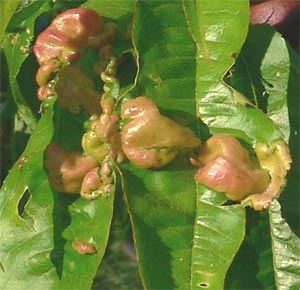(SOURCE: NCBI database)
KINGDOM: Fungi
DIVISION: Ascomycota
CLASS: Taphrinomycetes
ORDER: Taphrinales
FAMILY: Taphrinaceae
GENUS: Taphrina
SPECIES: deformans

Peach and almond trees sometimes develop blisters on their leaves such as seen at the left. The blistering may be so severe that entire leaves twist and curl until they hardly look like leaves at all. The disease also infects the host's flowers, fruits and young twigs. As the season progresses the leaves turn gray and powdery, the powder consisting of elongated, sac-like structures, the asci. This isn't a surprise since the disease organism, Taphrina deformans, is a member of the Ascomycota, where sexual reproduction is accomplished with asci.
The asci, arisen from hyphae inside the leaf, have broken through the leaf's cuticle, or "skin." One ascus produces eight spores, or ascospores, which during the warm months are transferred by wind and rain. Eventually the leaves turn brown or yellow and fall off early. Diseased fruits usually have wrinkled areas, are discolored and swollen, lack normal peach fuzz, and also fall off early.
When fall's cooler, wetter days, the ascospores germinate to produce asexual, conidia-type spores in such numbers that by winter a film of conidia covers the tree's surface (U. of California webpage). In spring, these spores infect new leaves as they emerge from their buds, and the cycle begins again.
Notice that no ascus cup -- a feature of most Ascomycota -- is mentioned above, just elongated asci. This species is regarded as having evolved before specialized ascospore-producing structures appeared.